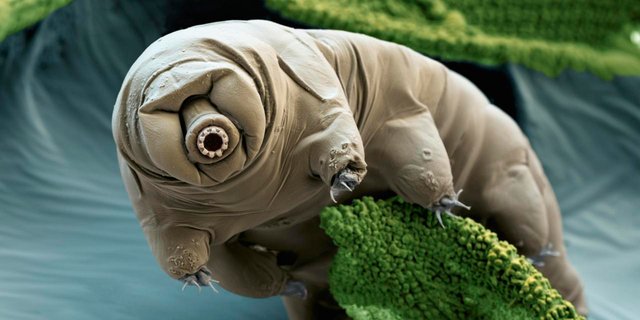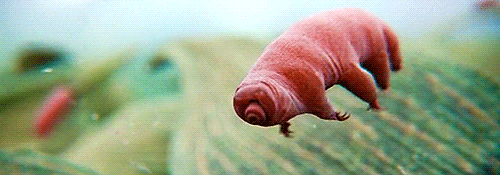
Image source https://news.nationalgeographic.com/2015/11/151128-animals-tardigrades-water-bears-science-dna/
This tiny guy's name is Tardigrade, but he has many other nicknames such as water bear, space bear or moss piglet, although he does not like a bear nor piglet.

Image source http://www.bbc.com/earth/story/20150313-the-toughest-animals-on-earth
This is much better view.

GIF source https://medium.com/the-funky-hedgehog/when-tardigrades-turn-to-the-dark-side-murder-bears-e0a2279e5171
This is one pink tardigrade walking and trying to eat. Nickname water bear comes from the way they walk. It apparently reminded scientist who discovered tardigrades of bear's gait...although bear does not have 8 legs, I can see certain similarities.
FACTS
Tardigrades are microscopic animals, with length of 0.1 mm for small ones, up to 1.5 mm for adults. As I already mentioned they are 8 legged animals. Their body is segmented, consisted of three segments each carrying one pair of legs, and last, caudal segment carrying fourth pair. All of their feet have 4 to 8 tiny claws.
WHERE DO THEY LIVE?
Usually they can be found in moss, lichens, soil, dunes and other dump habitats all over the world.
BUT...
Scientist have reported tardigrades on the top of the Himalayas.
 Image source https://www.pinterest.com/pin/502855114619463961/
Image source https://www.pinterest.com/pin/502855114619463961/
Or in hot springs, or deep under Antarctica ice. Or deep in the oceans. In tropical rainforest or in deserts.
WHAT DO THEY EAT?
Prey of tardigrades include bacteria, plants and even other tardigrades!
Some of them are carnivores and some are omnivores.
How do they hunt? They have specialized suckers (that tube shaped thing on their face) and they use it to suck out nutrients from inside of plants and animals. Pretty impressive.
EXTREME ENVIRONMENTS
Here is the interesting part. They can survive some some unbelievable conditions. Aside from living deep under the ice, or on mountain tops, or in acidic waters, what you are going to read next, is making tardigrades champions of survival.
Extreme temperatures
They can easily survive temperatures from -200 C to 151 C. They can even survive couple of minutes at the temperature of -272 C, which is only 1 degree above the absolute zero!
Pressure
As I mentioned before, some tardigrades live deep in the ocean, so they can withstand extremely high pressure, up to 1200 atmospheres. On the other side they can survive the extremely low pressure of vacuum.
Dehydration
It is known that tardigrades can survive up to 10 years without water. Just compare that to how many days humans can survive without water. Also, one specimen was found in dried moss museum sample, being 120 years without water. After rehydrating leg movements were noticed. So, apparently there is possibility of even bringing them back from dead!
Radiation
They can survive extreme amount of radiation. I guess you are not familiar with radiation units, so I will make comparisons. They can survive radiation dose that is 1000 time more than a dose that is lethal for human beings!
Outer space
Yes, even this! In one experiment, adult tardigrades were in outer space for 10 days, exposed to vacuum pressure and heavy radiation. After being brought back to Earth, and after rehydration, some specimens revived after just 30 minutes!
HOW THEY DO IT?
Anhydrobiosis
This term is derived from Greek word for 'life without water'.
For most animals, cell membranes collapse without water to hold them in place and die. But tardigrades are able of producing specific protein which supports their cells. Although, this can't be classified as life, because life implies ongoing biochemical reactions, this protein substitute allows tardigrades to be revived after long period of time.
Cryobiosis
This is how they survive extremely low temperatures. In low temperature environment, water inside cells freezes, damages membranes and cells die. Using this process tardigrades convert water into sugar molecules such as trehalose, so they keep their cell membranes intact.
Anoxybiosis
They also survive without oxygen. How?
In absence of water they stretch out in a long, relaxed state. In this state their metabolism is reduced and relaxed muscles allow as much water and oxygen as possible to enter their cells.
Radiation
When exposed to radiation our DNA mutates, and this can be lethal to all living organisms. Except for tardigrades. They have specific protein which is called DSUP (for 'damage suppressor'). This protein prevents tardigrade DNA get damaged under heavy radiation.
Now you probably understand how they can survive in open space, which is combination of everything mentioned above-extreme pressure, extreme temperature, no oxygen, extreme radiation.
DNA
And something really intriguing for the end.
Scientist sequenced complete tardigrade genome, and 1/6 of their genome is of foreign origin.
This, actually, means that 1/6 of their genome is stolen from other species. More precisely, genes can get ''stolen'' through a process of horizontal gene transfer (HGT). HGT occurs occasionally with all species, even humans, as a result of gene swapping with viruses. But, usually less than 1% of genome is made out of foreign DNA
CONCLUSION
What to say for the end, except for stating that these guys, although small, are really tough!


 Image source https://www.pinterest.com/pin/502855114619463961/
Image source https://www.pinterest.com/pin/502855114619463961/
I really love your posts. they are interesting, well written, and informative. Since your posts are science based, you might be interested in the SteemStem project. Tagging your posts with steemstem can help to get you noticed by the steemstem team.
Really interesting. good friend publication